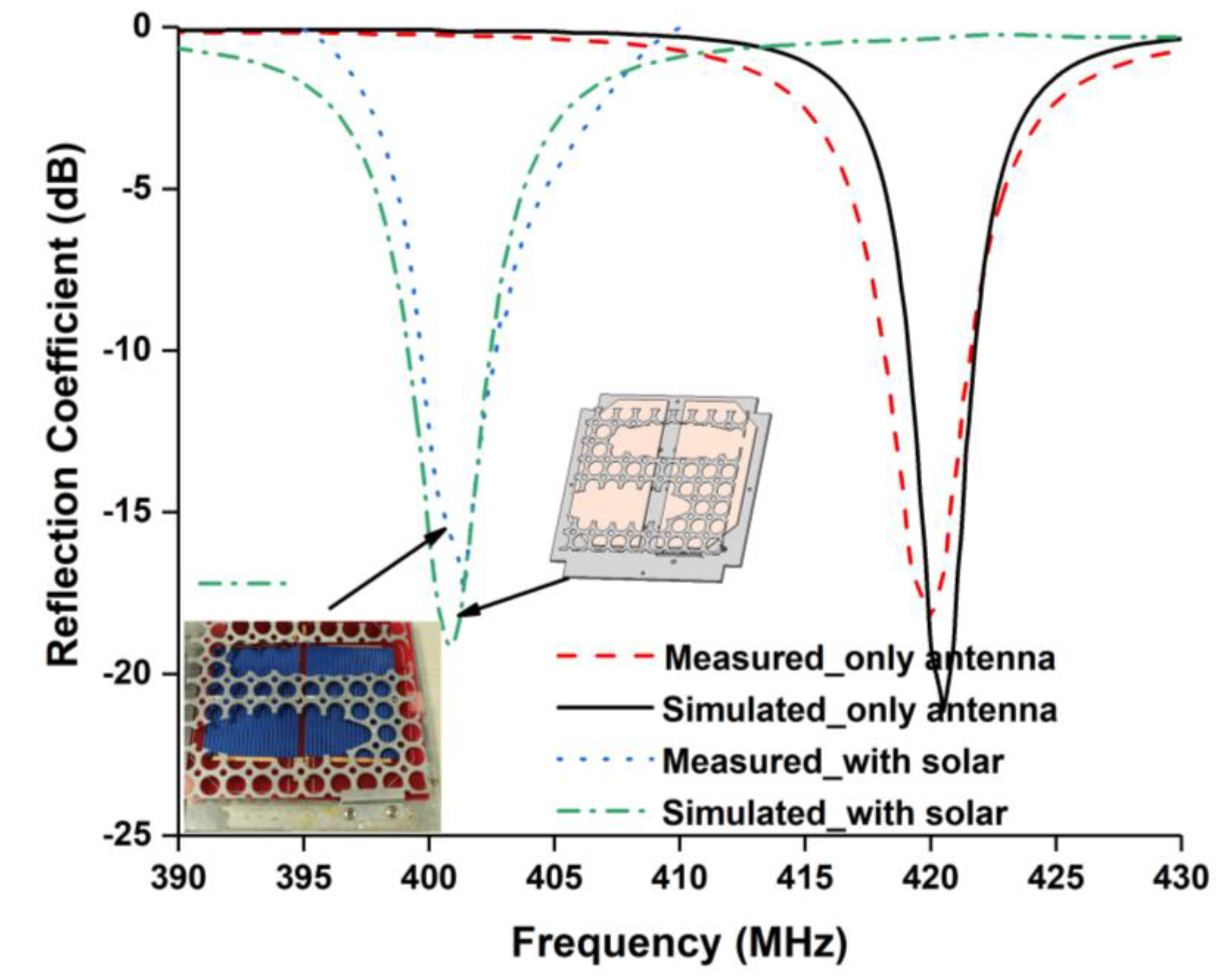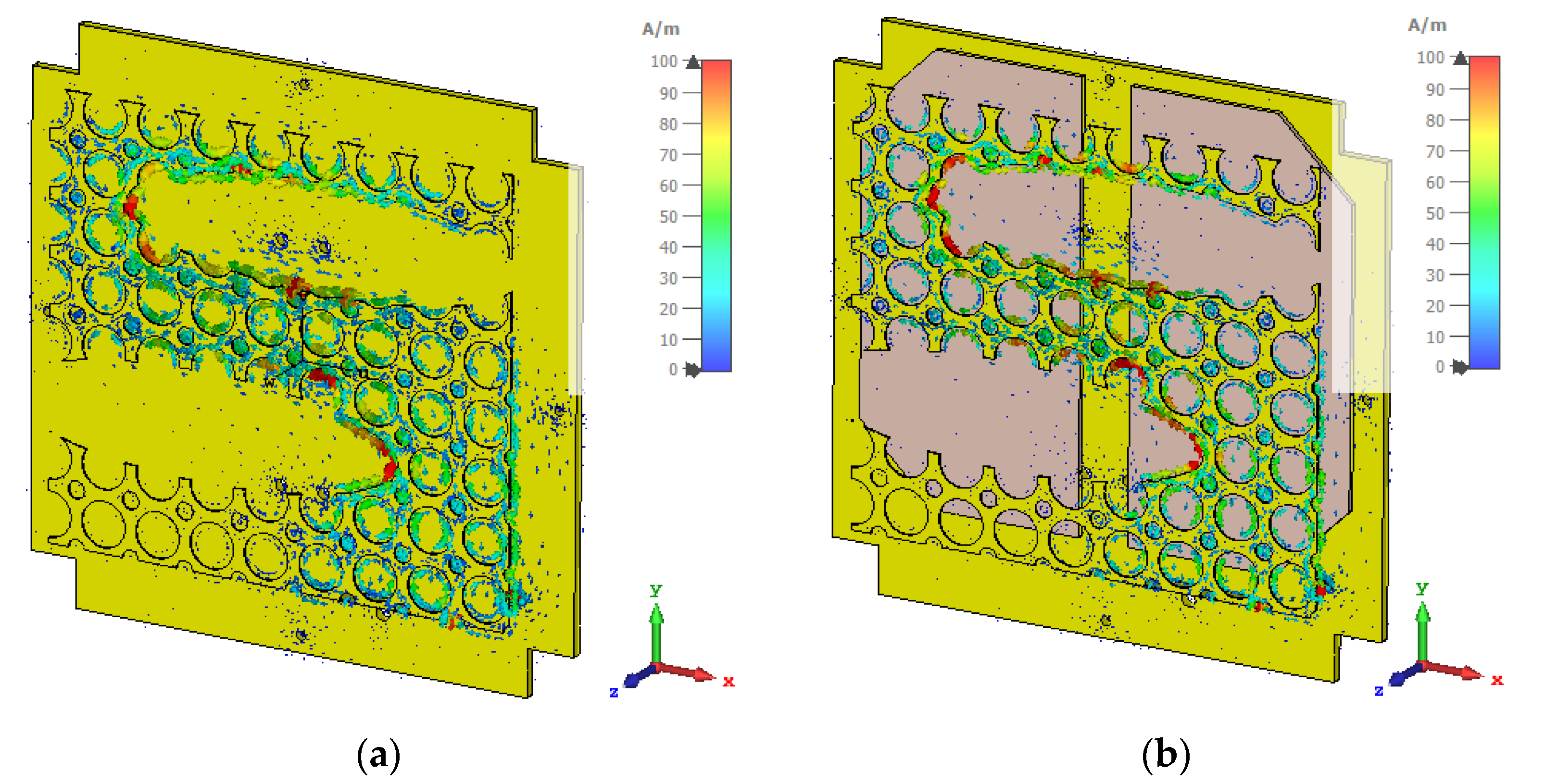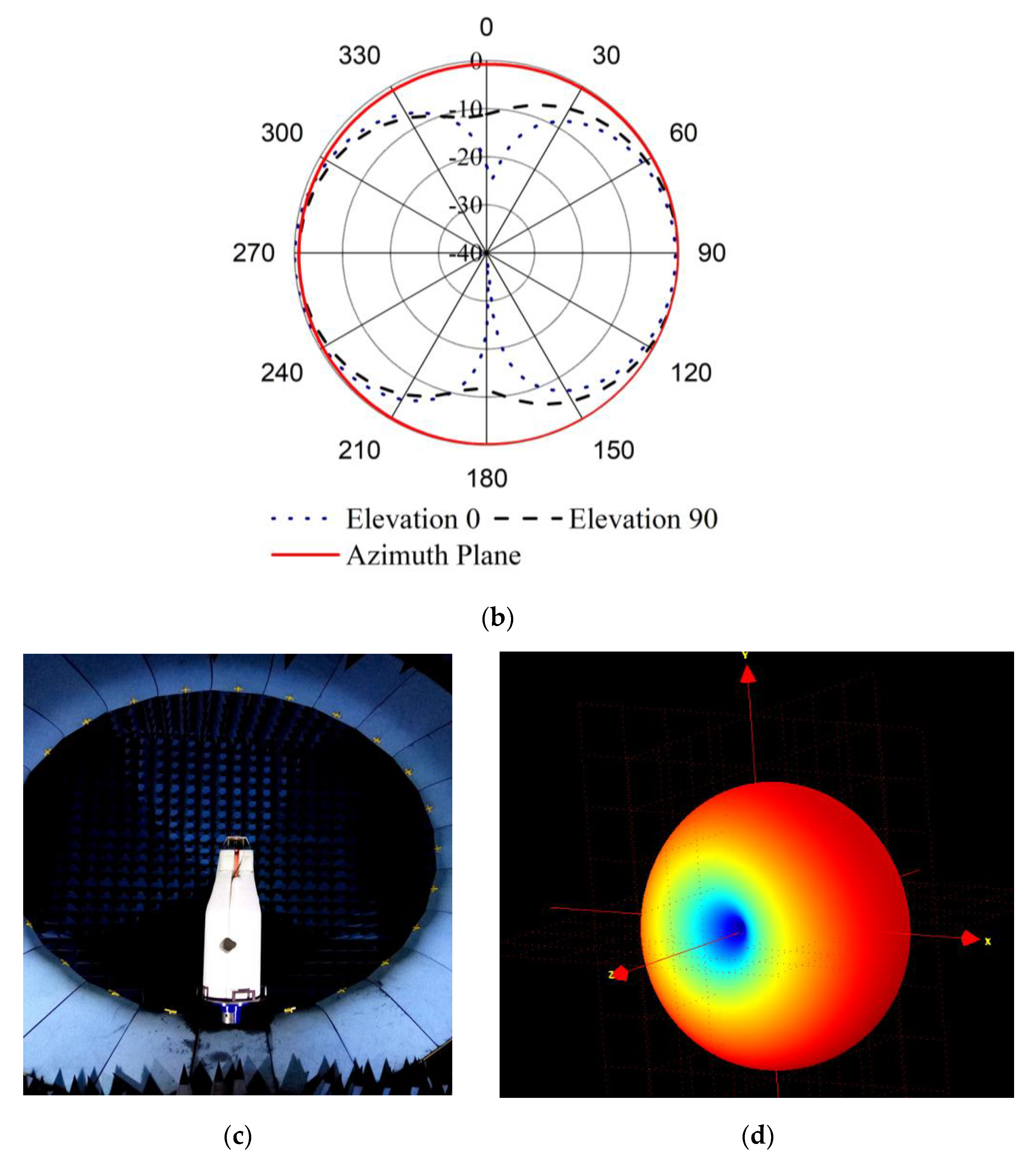Lower Ultra-High Frequency Non-Deployable Omnidirectional Antenna for Nanosatellite Communication System
Abstract
:1. Introduction
2. Antenna Design
3. Results and Discussions
4. Conclusions
Author Contributions
Funding
Data Availability Statement
Acknowledgments
Conflicts of Interest
References
- Kulu, E. Nanosats Database|Constellations, Companies, Technologies and More. Available online: https://www.nanosats.eu/ (accessed on 1 April 2021).
- Rahmat-Samii, Y.; Manohar, V.; Kovitz, J.M. For Satellites, Think Small, Dream Big: A review of recent antenna developments for CubeSats. IEEE Antennas Propag. Mag. 2017, 59, 22–30. [Google Scholar] [CrossRef]
- Gao, S.; Rahmat-Samii, Y.; Hodges, R.E.; Yang, X.-X. Advanced Antennas for Small Satellites. Proc. IEEE 2018, 106, 391–403. [Google Scholar] [CrossRef]
- Ernest, A.J.; Tawk, Y.; Costantine, J.; Christodoulou, C.G. A Bottom Fed Deployable Conical Log Spiral Antenna Design for CubeSat. IEEE Trans. Antennas Propag. 2014, 63, 41–47. [Google Scholar] [CrossRef]
- Fujishige, T.; Ohta, A.; Tamamoto, M.; Goshi, D.; Murakami, B.; Akagi, J.; Shiroma, W. Active antennas for cubesat applications. In Proceedings of the 16th AIAA/USU Annual Small Satellites Conference, Logan, UT, USA, 20 October 2002; p. SSC02-V-2. [Google Scholar]
- Kakoyiannis, C.; Constantinou, P. Electrically small microstrip antennas targeting miniaturized satellites: The cubesat paradigm. In Microstrip Antennas; InTech Open Access Publisher: London, UK, 2011; pp. 273–316. [Google Scholar]
- Islam, M.T.; Cho, M.; Samsuzzaman, M.; Kibria, S. Compact Antenna for Small Satellite Applications [Antenna Applications Corner]. IEEE Antennas Propag. Mag. 2015, 57, 30–36. [Google Scholar] [CrossRef]
- Samsuzzaman, M.; Islam, M.T.; Kibria, S.; Cho, M. BIRDS-1 CubeSat Constellation Using Compact UHF Patch Antenna. IEEE Access 2018, 6, 54282–54294. [Google Scholar] [CrossRef]
- Mathur, R.; Haupt, R.; Swenson, C. Student antenna design for a nanosatellite. In Proceedings of the 2001 IEEE Aerospace Conference Proceedings (Cat. No. 01TH8542), Big Sky, MT, USA, 10–17 March 2001; Volume 7, pp. 7–3688. [Google Scholar]
- Buckley, J.; Gaetano, D.; McCarthy, K.; Loizou, L.; O’Flynn, B.; O’Mathuna, C. Compact 433 MHz antenna for wireless smart system applications. Electron. Lett. 2014, 50, 572–574. [Google Scholar] [CrossRef]
- Podilchak, S.K.; Caillet, M.; Lee, D.; Antar, Y.M.M.; Chu, L.; Cain, J.; Hammar, M.; Caldwell, D.; Barron, E. Compact antenna for microsatellite using folded shorted patches and an integrated feeding network. In Proceedings of the 2012 6th European Conference on Antennas and Propagation (EUCAP), Prague, Czech Republic, 26–30 March 2012; pp. 1819–1823. [Google Scholar]
- Podilchak, S.K.; Murdoch, A.P.; Antar, Y.M. Compact, Microstrip-Based Folded-Shorted Patches: PCB antennas for use on microsatellites. IEEE Antennas Propag. Mag. 2017, 59, 88–95. [Google Scholar] [CrossRef]
- Alam, T.; Almutairi, A.F.; Samsuzzaman, M.; Cho, M.; Islam, M.T. Metamaterial array based meander line planar antenna for cube satellite communication. Sci. Rep. 2021, 11, 14087. [Google Scholar] [CrossRef] [PubMed]
- Alam, T.; Islam, M.T.; Cho, M. Near-zero metamaterial inspired UHF antenna for nanosatellite communication system. Sci. Rep. 2019, 9, 3441. [Google Scholar] [CrossRef] [PubMed]
- Nashad, F.; Foti, S.; Smith, D.; Elsdon, M.; Yurduseven, O. Development of transparent patch antenna element integrated with solar cells for Ku-band satellite applications. In Proceedings of the 2016 Loughborough Antennas & Propagation Conference (LAPC), Loughborough, UK, 14–15 November 2016; pp. 1–5. [Google Scholar]
- Selamat, A.; Misran, N.; Mansor, M.F.; Islam, M.T.; Zaidi, S.H. Scattering Microwave Signal Analysis from Triangular Loop Element of Different Transparent Conductive Thin Films at Ku-band (Analisis Penyerakan Isyarat Gelombang Mikro Elemen Gelung Segi Tiga dari Pelbagai Jenis Filem Pengalir Lutsinar pada Jalur-Ku). J. Kejuruter. 2014, 26, 83–88. [Google Scholar] [CrossRef]
- Paul, L.C.; Pramanik, R.K.; Rashid, M.U.; Sarker, S.; Mahmud, Z.; Islam, M.T. An ITO Based High Gain Optically Transparent Wide Band Microstrip Antenna for K Band Satellite Communication. In Proceedings of the 2019 International Conference on Robotics, Electrical and Signal Processing Techniques (ICREST), Dhaka, Bangladesh, 10–12 January 2019; pp. 638–642. [Google Scholar]
- Liu, X.; Jackson, D.R.; Chen, J.; Liu, J.; Fink, P.W.; Lin, G.Y.; Neveu, N. Transparent and Nontransparent Microstrip Antennas on a CubeSat: Novel low-profile antennas for CubeSats improve mission reliability. IEEE Antennas Propag. Mag. 2017, 59, 59–68. [Google Scholar] [CrossRef]
- Alam, T.; Islam, M.T.; Ullah, M.A.; Cho, M. A Solar Panel-Integrated Modified Planner Inverted F Antenna for Low Earth Orbit Remote Sensing Nanosatellite Communication System. Sensors 2018, 18, 2480. [Google Scholar] [CrossRef] [PubMed]
- Alam, T.; Islam, M.T.; Ullah, A.; Rahmatillah, R.; Aheieva, K.; Lap, C.C.; Cho, M. Design and compatibility analysis of a solar panel integrated UHF antenna for nanosatellite space mission. PLoS ONE 2018, 13, e0205587. [Google Scholar] [CrossRef] [PubMed]
- Hu, H.; Liao, W.; Hou, L.; Sun, F.; Zhang, G.; Ren, C.; Zhang, X. Compact Planar Inverted-F Antenna for MicroSats Omnidirectional Communications. IEEE Antennas Wirel. Propag. Lett. 2020, 20, 160–164. [Google Scholar] [CrossRef]
- Haruki, H. The inverted-F antenna for portable radio units. Conv. Rec. IECE Japan Mar. 1982, 1982, 10022296062. [Google Scholar]
- Tsunoda, K.; Taga, T. Analysis of planar inverted F antenna using spatial network method. In Proceedings of the International Symposium on Antennas and Propagation Society, Merging Technologies for the 90’s, Dallas, TX, USA, 7–11 May 1990; pp. 664–667. [Google Scholar]
- Yekan, T.; Baktur, R. Conformal Integrated Solar Panel Antennas: Two effective integration methods of antennas with solar cells. IEEE Antennas Propag. Mag. 2017, 59, 69–78. [Google Scholar] [CrossRef]
- Zalfani, N.; Beldi, S.; Lahouar, S.; Besbes, K. Miniaturized Planar Meander Line Antenna for UHF CubeSat Communication. Adv. Space Res. 2021, 69, 2240–2247. [Google Scholar] [CrossRef]







| Parameters | Value (mm) | Parameters | Value (mm) |
|---|---|---|---|
| L | 100 | L4 | 8.5 |
| W | 100 | L5 | 8.5 |
| h | 5 | a1 | 36 |
| L1 | 86 | a2 | 40 |
| L2 | 78 | b1 | 10 |
| L3 | 24 | b2 | 7 |
| r1 | 4 | r2 | 1.5 |
| Condition | Solar Panel Rotation (Deg) | Solar Panel Output Power (W) | Effective Power (%) |
|---|---|---|---|
| Normal Solar panel | 0° | 0.926 | 100 |
| Solar power integrated with Antenna structure | 0° | 0.885 | 95.57 |
| 45° | 0.663 | 71.60 | |
| 60° | 0.625 | 67.5 |
| Antenna | Size (mm) | Operating Frequency (MHz) | Gain (dB) | Remarks |
|---|---|---|---|---|
| Folded Microstrip antenna [12] | 150 × 150 × 37 | 384–410 | 0.4 | Larger size and incompatible with 1U nanosatellite |
| Patch antenna [14] | 80 × 45 × 1.575 | 391–405.92 | 1.77 | Compatible with 1U nanosatellite but occupied solar panel space |
| Patch antenna [13] | 80 × 40 × 3.35 | 443.5–455 | 2.5 | Compatible with 1U nanosatellite but occupied solar panel space |
| Modified PIFA [19] | 80 × 90 × 6 | 447.5–453.5 | 0.6 | Solar panel integrated with 1U nanosatellite |
| Inverted-F antenna [21] | 85 × 85 × 31 | 401.8 | 5.37 | High gain but incompatible with 1U nanosatellite |
| Meander line patch [25] | 50 × 80 × 1.635 | 920 | 1.8 | Compatible with 1U nanosatellite but occupied solar panel space |
| Proposed (Modified PIFA) | 78 × 86 × 5 | 399.2–402.5 | 0.672 | Solar panel integrated with 1U nanosatellite |
Publisher’s Note: MDPI stays neutral with regard to jurisdictional claims in published maps and institutional affiliations. |
© 2022 by the authors. Licensee MDPI, Basel, Switzerland. This article is an open access article distributed under the terms and conditions of the Creative Commons Attribution (CC BY) license (https://creativecommons.org/licenses/by/4.0/).
Share and Cite
Alam, T.; Sheikh, M.M.; Aldhaheri, R.W.; Singh, M.S.J.; Cho, M.; Islam, M.T.; Alharbi, K.H.; Islam, M.S. Lower Ultra-High Frequency Non-Deployable Omnidirectional Antenna for Nanosatellite Communication System. Nanomaterials 2022, 12, 3143. https://doi.org/10.3390/nano12183143
Alam T, Sheikh MM, Aldhaheri RW, Singh MSJ, Cho M, Islam MT, Alharbi KH, Islam MS. Lower Ultra-High Frequency Non-Deployable Omnidirectional Antenna for Nanosatellite Communication System. Nanomaterials. 2022; 12(18):3143. https://doi.org/10.3390/nano12183143
Chicago/Turabian StyleAlam, Touhidul, Muntasir M. Sheikh, Rabah W. Aldhaheri, Mandeep Singh Jit Singh, Mengu Cho, Mohammad Tariqul Islam, Khalid H. Alharbi, and Md. Shabiul Islam. 2022. "Lower Ultra-High Frequency Non-Deployable Omnidirectional Antenna for Nanosatellite Communication System" Nanomaterials 12, no. 18: 3143. https://doi.org/10.3390/nano12183143
APA StyleAlam, T., Sheikh, M. M., Aldhaheri, R. W., Singh, M. S. J., Cho, M., Islam, M. T., Alharbi, K. H., & Islam, M. S. (2022). Lower Ultra-High Frequency Non-Deployable Omnidirectional Antenna for Nanosatellite Communication System. Nanomaterials, 12(18), 3143. https://doi.org/10.3390/nano12183143






